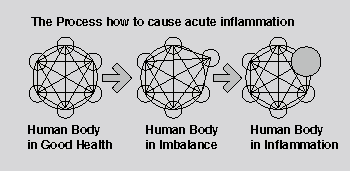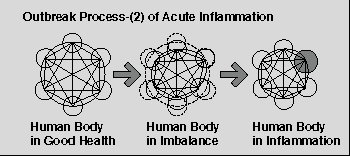 |
 |
|
|
|
 |
III. Inflammation 1/4
What is acute inflammation? |
|
|
|
|
|
|
1. Theoretical Analysis of Acute Inflammation
First of all, let me explain my definition of inflammation. "When a tissue changes the momentum relatively to the background tissues and loses the balance in momentum with them, it causes inflammation in order to neutralize the imbalance." To check this definition, let us consider firstly why a tissue in this condition causes inflammation.
(a) Outbreak Mechanism of Acute Inflammation
A tissue can theoretically be considered to cause acute inflammation when it increases the momentum relatively to the background tissues. This mechanism can be deduced from swelling change, which is one of the representative changes seen in acute inflammation.
Swelling change occurs through two steps. At the first step, a tissue raises the momentum relatively to the background tissues. When a tissue raises the momentum, it also raises the energy density compared with the background tissues. Then the tissue causes the imbalance in energy density with the background tissues. At the next step, to neutralize this imbalance in energy density, the tissue accumulates an excessive amount of watery fluid because watery fluid has low energy density compared with a cell. As a result, the tissue swells. The figures below illustrate this process. That is, a tissue raising the momentum can be considered to cause acute inflammation.
(Notes: Notice that edematous change also occurs almost by the same mechanism. Ascites, for instance, can theoretically be occurred to reduce the high energy density in the abdominal cavity. This reveals that disease causing ascites, such as cirrhosis, renal disfunction and so on, causes the imbalance in energy density between organs.) |
|
|
|

|
|
(When a tissue raises the momentum, it causes the imbalance in energy density with the background field. Then it causes acute inflammation in order to neutralize the imbalance in energy density.) |
|
|
|
(b) Two Types of Acute Inflammation
Acute inflammation can be classified into two types. Specifically, one occurs when a tissue raises the momentum; the other occurs when the background field of a tissue reduces the momentum. Interestingly enough, whereas we can easily treat the former case, we cannot easily treat the latter one.
In the former case, a tissue tends to show a quick recovery from the inflammation, and its treatment is easy. This tissue raises the momentum for itself, and then causes acute inflammation. This means that the fundamental cause of this case originates only in the tissue. Thus, as soon as after the tissue is treated with medicines, it will get well soon. In short, the treatment for this acute inflammation is easy.
In the latter case, a tissue tends to show a slow recovery from the inflammation, and its treatment is difficult compared with a tissue in the former case. This tissue does not raise the momentum for itself; that is, it relatively raises the momentum compared with the background tissues because the background field reduces the momentum. Thus, even when only this tissue is treated with medicines, it does not get well soon. Then this tissue tends to change its condition into chronic inflammation. In short, compared with the treatment for acute inflammation in the former case, the treatment for this type of acute inflammation is difficult. (This detailed explanation will be written on the next page.)
The figures below illustrate the outbreak process of acute inflammation seen in the latter case. |
|
|
|

|
|
(When the background field of a tissue reduces the momentum, it causes the imbalance in energy density with the tissue. Then, because the tissue is smaller than the background field, it causes acute inflammation in order to neutralize the imbalance.) |
|
|
|